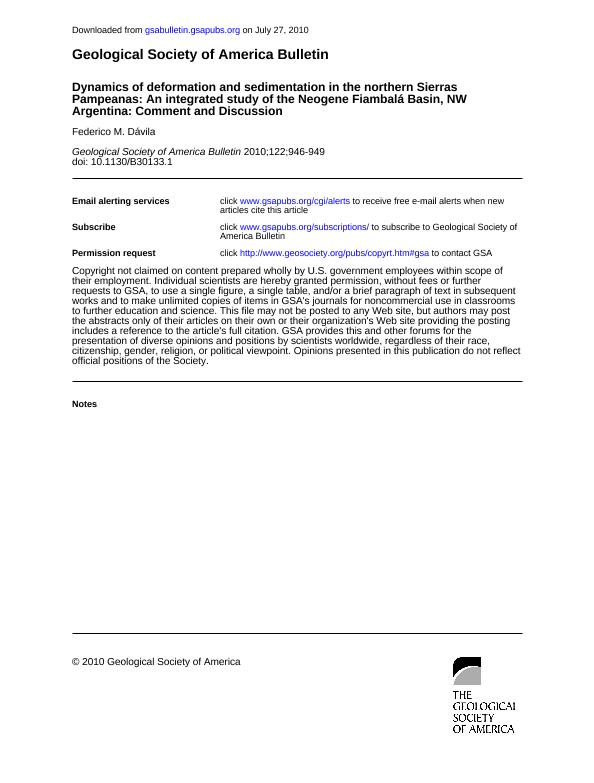Mostrar el registro sencillo del ítem
dc.contributor.author
Davila, Federico Miguel

dc.date.available
2018-08-07T15:55:13Z
dc.date.issued
2010-05
dc.identifier.citation
Davila, Federico Miguel; Dynamics of deformation and sedimentation in the northern Sierras pampeanas: An integrated study of the neogene Fiambalá basin, NW argentina: Comment and discussion; Geological Society of America; Geological Society Of America Bulletin; 122; 5-6; 5-2010; 946-949
dc.identifier.issn
0016-7606
dc.identifier.uri
http://hdl.handle.net/11336/54427
dc.description.abstract
In a recent contribution to the Geological Society of America Bulletin, Carrapa et al. (2008) provided an interesting geochronological and thermoChronological database for the Fiambalá Basin, northern end of the Sierras Pampeanas, which, together with stratigraphic, sedimentological and structural data, led them to interpret a late Miocene–Pliocene foreland reorganization from a simple scenario (e.g., DeCelles and Giles, 1996) to settings dominated by intermontane basement thrusting. They associated this reorganization with the beginning of fl at subduction, which would have been coeval (according to Carrapa et al., 2008) with broken foreland stages in the Bermejo Basin (>400 km south). One of the most crucial issues that Carrapa et al. (2008, p. 1518–1543) address (in their words) is “the structural and sedimentary behavior of broken forelands and their relationships with large-scale plate-tectonic processes such as fl at-slab subduction” that can “contribute to a better understanding of the transition from unbroken foreland (thin-skinned) to broken foreland (thick-skinned) styles of deformation and related sedimentation.” However, for some reason, they did not discuss the entire Andean stratigraphy of the area, superbly exposed much less than 50 km southward and 100 km northward of their study region (in central Famatina and Southern Puna, respectively; see Fig. 1). These two regions are evidently much closer than the Bermejo Basin exposures (see Jordan et al., 2001), which were used as a key correlation. The Bermejo Basin is located at ~31°S, i.e., ~400 km southward of Fiambalá (Fig. 1). Although I do agree that the entire extent of the Sierras Pampeanas shows evidences of basement- thrusting tectonics during the late Miocene to Pliocene and even during the Quater nary (already demonstrated previously; e.g., Jordan and Allmendinger, 1986; Ramos et al., 2002; among others), there are sources that indicate the foreland partitioning would have begun earlier. Particularly, I disagree with: (1) the timing of transformation from “simple fl exural stages” to “broken foreland scenarios” and (2) their interpretation about a synchronous slab shallowing at ca. 6 Ma. This discussion is divided into four lines of reasoning: mapping and stratigraphy of Tertiary sequences in Famatina and Southern Puna; timing of basement thrusting in boundary regions; thermochronology; and evidences of flat subduction between 29°S and 26°S.
dc.format
application/pdf
dc.language.iso
eng
dc.publisher
Geological Society of America

dc.rights
info:eu-repo/semantics/openAccess
dc.rights.uri
https://creativecommons.org/licenses/by-nc-sa/2.5/ar/
dc.subject
Antepais Fragmentado
dc.subject
Cuencas
dc.subject
Deformacion de Zocalo
dc.subject.classification
Meteorología y Ciencias Atmosféricas

dc.subject.classification
Ciencias de la Tierra y relacionadas con el Medio Ambiente

dc.subject.classification
CIENCIAS NATURALES Y EXACTAS

dc.title
Dynamics of deformation and sedimentation in the northern Sierras pampeanas: An integrated study of the neogene Fiambalá basin, NW argentina: Comment and discussion
dc.type
info:eu-repo/semantics/article
dc.type
info:ar-repo/semantics/artículo
dc.type
info:eu-repo/semantics/publishedVersion
dc.date.updated
2018-08-02T14:49:20Z
dc.identifier.eissn
1943-2674
dc.journal.volume
122
dc.journal.number
5-6
dc.journal.pagination
946-949
dc.journal.pais
Estados Unidos

dc.journal.ciudad
Boulder
dc.description.fil
Fil: Davila, Federico Miguel. Consejo Nacional de Investigaciones Científicas y Técnicas. Centro Científico Tecnológico Conicet - Córdoba. Centro de Investigaciones en Ciencias de la Tierra. Universidad Nacional de Córdoba. Facultad de Ciencias Exactas Físicas y Naturales. Centro de Investigaciones en Ciencias de la Tierra; Argentina
dc.journal.title
Geological Society Of America Bulletin

dc.relation.alternativeid
info:eu-repo/semantics/altIdentifier/url/https://bit.ly/2OlRbhH
dc.relation.alternativeid
info:eu-repo/semantics/altIdentifier/doi/http://dx.doi.org/10.1130/B30133.1
Archivos asociados
